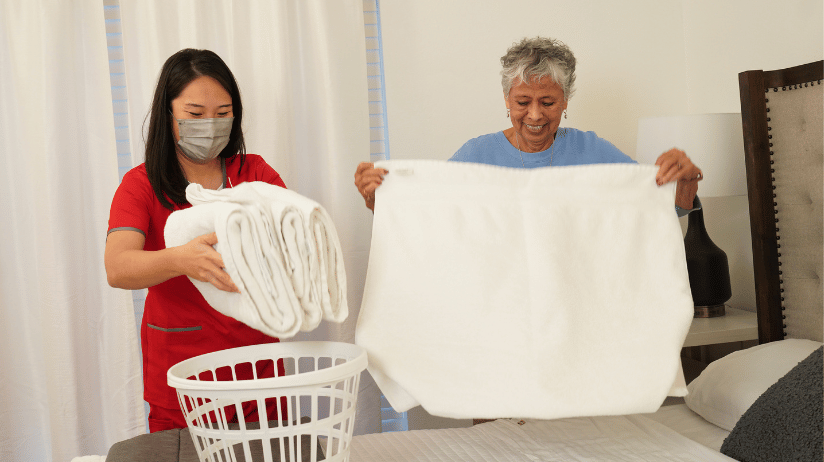Traditionally, home care has been underappreciated in the healthcare industry. Home care includes a wide range of non-medical services that can help older adults remain healthy at home. However, COVID-19 helped prove that home care services effectively keep seniors safe and healthy.
In a post-COVID world, home care is gaining traction, and demand for services has surged. But the pandemic also served as a powerful catalyst for change across the industry. Let's explore how COVID-19 reshaped the landscape of home care.
Increased Desire to Remain at Home
During the pandemic, nursing homes and assisted living facilities turned into breeding grounds for infection. Instead of helping seniors remain healthy, they turned into a huge threat. The pandemic exposed weaknesses in this part of the healthcare system as the virus quickly spread.
On the other hand, seniors who remained at home were able to more effectively avoid the virus and remain safe. Post-COVID, more adults than ever desire to live independently at home as long as possible instead of moving into a facility.
And family members look to home care to help keep their loved ones healthy and safe. Adult children are thinking twice before sending their loved ones to a skilled nursing home or assisted living facility. Remaining at home helps maintain quality of life and has proven to be a safer option.
RELATED CONTENT: 7 Rewarding Trends in the Home Care Market
Opportunities for Expanded Services
Many facilities faced staffing shortages during the pandemic, and some still do. Caregivers from home care companies helped fill these gaps, freeing up time for skilled providers to attend to medical needs.
A caregiver's domain expanded from the client's home to any setting where an individual receives medical care. In the future, we expect more partnerships between home care agencies and senior living communities to meet staffing demands.
Telehealth & Remote Monitoring
One of the most notable changes in the home care industry spurred by COVID-19 is the widespread adoption of telehealth and remote monitoring technologies. When in-person visits became challenging and risky, healthcare providers turned to virtual consultations and remote monitoring solutions. This shift ensured continuity of care.
Today, healthcare providers are still utilizing telehealth visits, and families are more open to remote monitoring technologies. The pandemic showed that patients can still get high-level care and attention through technology.
Home care companies can leverage technology for fall detection, medication reminders, checking vital signs, and more. It can facilitate early intervention and proactive management of chronic conditions.
At Caring Senior Service, we offer remote monitoring devices and access to a 24/7 virtual care manager to support our clients. And we are always looking for new ways to adopt technological advancements to help our clients.
More Payment Options
Because home care has been underappreciated, there have been limited Medicaid and insurance coverage. That means that the majority of home care services are private pay, or paid out of a senior’s pocket. Medicare includes home medical services, like home health, but does not include non-medical services.
However, home care became more widely recognized as a valuable service to keep individuals healthy. As it proves its worth, we expect to see more federal payment opportunities emerge and inclusive insurance options. These payment opportunities could open doors to clients who may not be able to afford private pay.
We hope that more payment avenues for home care arise so seniors can get the care and attention they need and want.
More Attractive Job Market
COVID-19 also showed the country that job security may not be so secure. Historically, many individuals turned to restaurants or retail over home care jobs. This trend made it hard to attract workers and keep quality talent.
However, jobs in the home care industry offer more job security than other industries. With this advantage, home care companies may have an easier time attracting and keeping talent. There will always be a demand for services and, therefore, a demand for professional caregivers.
The hiring process also changed during COVID, with companies turning to virtual interviews and training. For some individuals, this makes the job-hunting process easier and more efficient.
RELATED CONTENT: 11 Recruitment Strategies for Effectively Hiring Caregivers
Licensing Requirements
Home care did not come out of the pandemic unscathed. The focus on elder care emphasized the lack of regulation in the industry. Some states require licensing, but most do not. This lack of oversight can lead to poor quality of care.
Caring Senior Service has internal standards, but there are no nationwide standards for quality of care. Licensing would create a uniform standard of care and ensure home care companies are more qualified across the country.
But licensing could cause smaller agencies to fade out of the home care industry and larger home care agencies to dominate the market.
Conclusion
COVID-19 taught us some valuable lessons about caring for our seniors. As we look towards the future, these changes are poised to transform the home care industry for the better, ensuring that patients receive the highest quality of care in the comfort and safety of their own homes.
Regardless of what happens, Caring Senior Service will remain a trusted home care provider to assist individuals with activities of daily living. We will always strive to help seniors remain healthy, happy, and at home.


